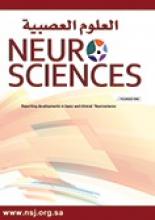Abstract
OBJECTIVE: To minimize the uncertainty in clinical diagnosis and improve the classification of 14 Tunisian patients belonging to 12 families and affected with congenital muscular dystrophy (CMD).
METHODS: Fourteen patients belonging to 12 unrelated families originating from the south of Tunisia and affected with CMD were clinically examined between 1990 and 2001 in the neurology service of Chu Habib Bourguiba, Sfax, Tunisia. Immunohistochemical and western blot analyses were used to explore protein expression in muscular biopsies and homozygosity mapping using microsatellite markers for the genetic study. These analyses were performed in the human molecular genetics laboratory.
RESULTS: Among the patients tested with anti-merosin antibodies, 3 showed total laminin-a2 deficiency and the remaining patients showed partial laminin-a2 deficiency. All patients expressed normally a-sarcoglycan, b-dystroglycan and dystrophin except 2 showing reduction of expression in a-sarcoglycan and b-dystroglycan. Linkage analysis, performed for 8 families, was compatible with linkage to the LAMA2 gene for only 2.
CONCLUSION: Our results showed that clinical and immunohistochemical analyses have allowed classification of only 3 patients, immunohistochemical and genotyping studies have contributed to the classification of 7 patients. In the remaining cases, there is no evident classification due to the lack of the genetic exploration. Our results also confirmed the broad spectrum of phenotypes associated with a defect in laminin-a2.
- Copyright: © Neurosciences
Neurosciences is an Open Access journal and articles published are distributed under the terms of the Creative Commons Attribution-NonCommercial License (CC BY-NC). Readers may copy, distribute, and display the work for non-commercial purposes with the proper citation of the original work.






